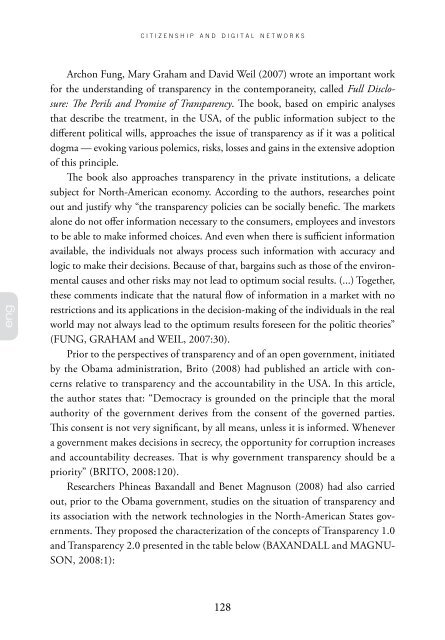Sergio Amadeu da Silveira - Cidadania e Redes Digitais
Sergio Amadeu da Silveira - Cidadania e Redes Digitais
Sergio Amadeu da Silveira - Cidadania e Redes Digitais
You also want an ePaper? Increase the reach of your titles
YUMPU automatically turns print PDFs into web optimized ePapers that Google loves.
eng<br />
c i t i z e n s h i p a n d d i g i t a l n e t w o r k s<br />
Archon Fung, Mary Graham and David Weil (2007) wrote an important work<br />
for the understanding of transparency in the contemporaneity, called Full Disclosure:<br />
The Perils and Promise of Transparency. The book, based on empiric analyses<br />
that describe the treatment, in the USA, of the public information subject to the<br />
different political wills, approaches the issue of transparency as if it was a political<br />
dogma — evoking various polemics, risks, losses and gains in the extensive adoption<br />
of this principle.<br />
The book also approaches transparency in the private institutions, a delicate<br />
subject for North-American economy. According to the authors, researches point<br />
out and justify why “the transparency policies can be socially benefic. The markets<br />
alone do not offer information necessary to the consumers, employees and investors<br />
to be able to make informed choices. And even when there is sufficient information<br />
available, the individuals not always process such information with accuracy and<br />
logic to make their decisions. Because of that, bargains such as those of the environmental<br />
causes and other risks may not lead to optimum social results. (...) Together,<br />
these comments indicate that the natural flow of information in a market with no<br />
restrictions and its applications in the decision-making of the individuals in the real<br />
world may not always lead to the optimum results foreseen for the politic theories”<br />
(FUNG, GRAHAM and WEIL, 2007:30).<br />
Prior to the perspectives of transparency and of an open government, initiated<br />
by the Obama administration, Brito (2008) had published an article with concerns<br />
relative to transparency and the accountability in the USA. In this article,<br />
the author states that: “Democracy is grounded on the principle that the moral<br />
authority of the government derives from the consent of the governed parties.<br />
This consent is not very significant, by all means, unless it is informed. Whenever<br />
a government makes decisions in secrecy, the opportunity for corruption increases<br />
and accountability decreases. That is why government transparency should be a<br />
priority” (BRITO, 2008:120).<br />
Researchers Phineas Baxan<strong>da</strong>ll and Benet Magnuson (2008) had also carried<br />
out, prior to the Obama government, studies on the situation of transparency and<br />
its association with the network technologies in the North-American States governments.<br />
They proposed the characterization of the concepts of Transparency 1.0<br />
and Transparency 2.0 presented in the table below (BAXANDALL and MAGNU-<br />
SON, 2008:1):<br />
128


